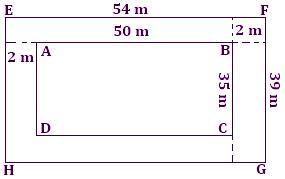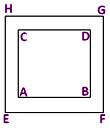Subscribe to our ▶️ YouTube channel 🔴 for the latest videos, updates, and tips.
Area of the Path
Here we will discuss about area of the path. It is observed that in square or rectangular gardens, parks, etc., some space in the form of path is left inside or outside or in between as cross paths. We will apply this concept for the areas of rectangle and square to determine the areas of different paths.
Worked-out examples on Area of the Path:
1. A rectangular lawn of length 50 m and breadth 35 m is to be surrounded externally by a path which is 2 m wide. Find the cost of turfing the path at the rate of $3 per m².

Solution:
Length of the lawn = 50 m
Breadth of the lawn = 35 m
Area of the lawn = (50 × 35) m²
= 1750 m²
Length of lawn including the path = [50 + (2 + 2)] m = 54 cm
Breadth of the lawn including the path = [35 + (2 + 2)] m = 39 m
Area of the lawn including the path = 54 × 39 m² = 2106 m²
Therefore, area of the path = (2106 - 1750) m² = 356 m²
For 1 m², the cost of turfing the path = $ 3
For 356 m², the cost of turfing the path = $3 × 356 = $1068
2. A painting is painted on a cardboard 19 cm and 14 cm wide, such that there is a margin of 1.5 cm along each of its sides. Find the total area of the margin.
Solution:
Length of the cardboard = 19 cm
Breadth of the cardboard = 14 cm
Area of the cardboard = 19 × 14 cm² = 266 cm²
Length of the painting excluding the margin = [19 - (1.5 + 1.5)] cm = 16 cm
Breadth of the painting excluding the margin = 14 - (1.5 + 1.5) = 11 cm
Area of the painting excluding the margin = (16 × 11) cm² = 176 cm²
Therefore, area of the margin = (266 - 176) cm² = 90 cm²
3. A square flowerbed is surrounded by a path 10 cm wide around it. If the area of the path is 2000 cm², find the area of the square flower-bed.
Solution:
In the adjoining figure,

ABCD is the square flowerbed.
EFGH is the outer boundary of the path.
Let each side of the flowerbed = x cm
Then, the area of the square flowerbed ABCD (x × x) cm² = x² cm²
Now, the side of the square EFGH = (x + 10 + 10) cm = (x + 20) cm
So, the area of square EFGH = (x + 20) (x + 20) cm² = (x + 20)² cm²
Therefore, area of the path = Area of EFGH - Area of ABCD
= [(x + 20)² - x²] cm²
= [x² + 400 + 40x - x²] cm² = (40x + 400) cm²
But the area of path given = 2000 cm²
Therefore, 40x + 400 = 2000
⟹ 40x = 2000 - 400
⟹ 40x = 1600
⟹ x = 1600/40 = 40
Therefore, side of square flowerbed =40 cm
Therefore, the area of the square flowerbed = 40 × 40 cm² = 1600 cm²
● Mensuration
Perimeter and Area of Rectangle
Area and Perimeter of the Triangle
Area and Perimeter of the Parallelogram
Circumference and Area of Circle
Practice Test on Area and Perimeter of Rectangle
Practice Test on Area and Perimeter of Square
● Mensuration - Worksheets
Worksheet on Area and Perimeter of Rectangles
Worksheet on Area and Perimeter of Squares
Worksheet on Circumference and Area of Circle
Worksheet on Area and Perimeter of Triangle
7th Grade Math Problems
8th Grade Math Practice
From Area of the Path to HOME PAGE
Didn't find what you were looking for? Or want to know more information about Math Only Math. Use this Google Search to find what you need.


New! Comments
Have your say about what you just read! Leave me a comment in the box below. Ask a Question or Answer a Question.